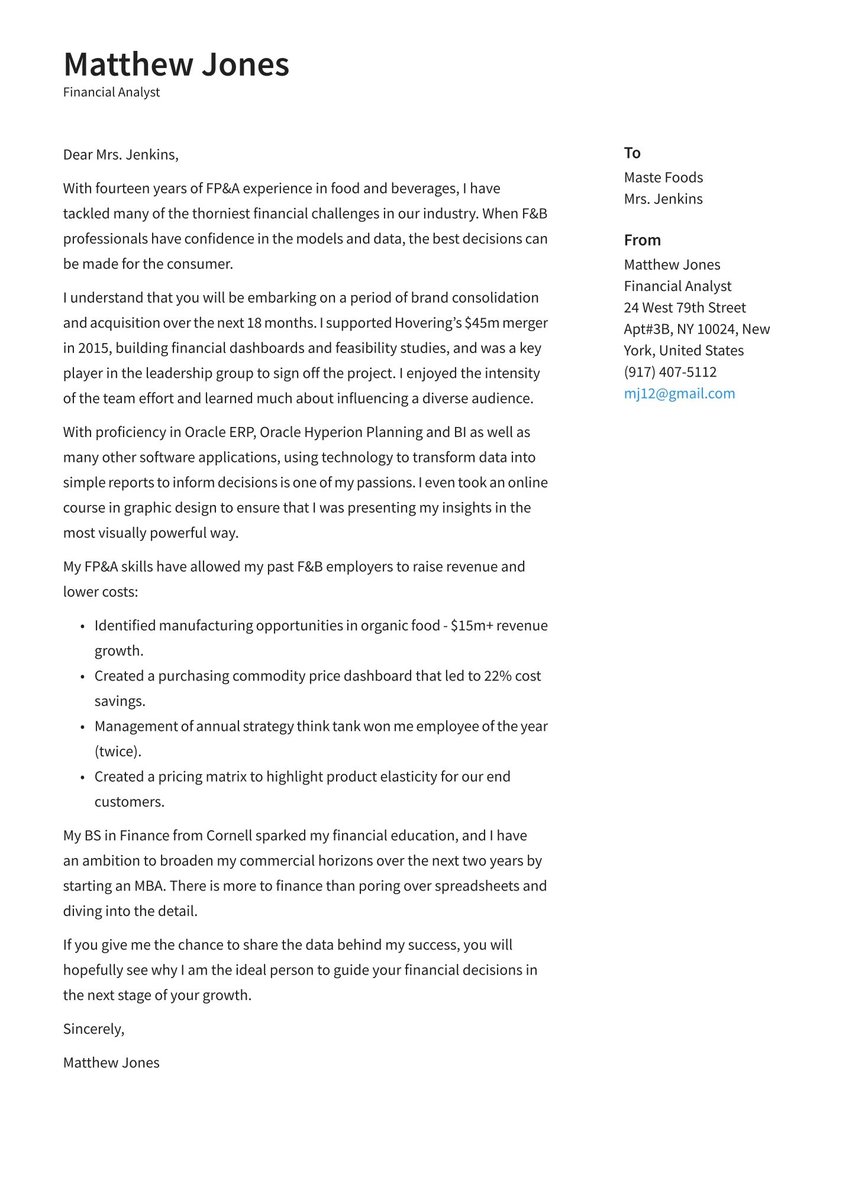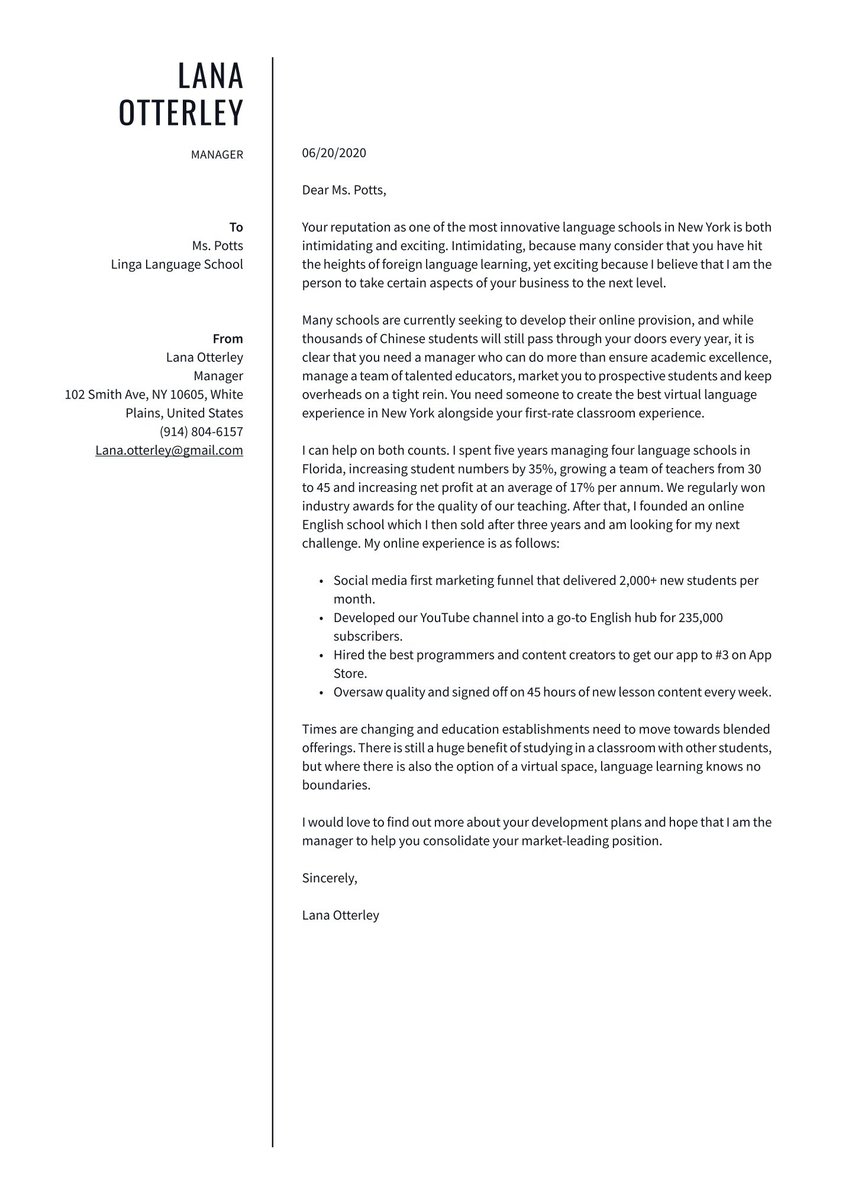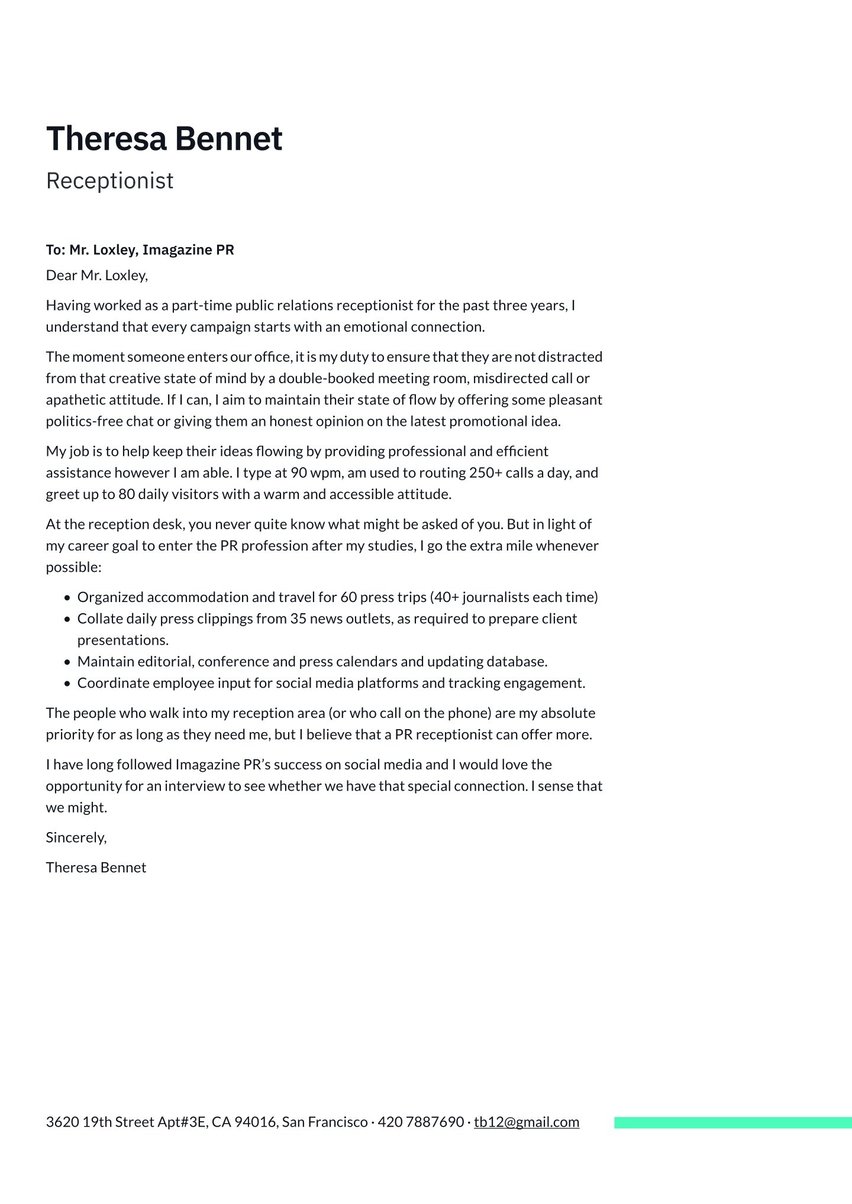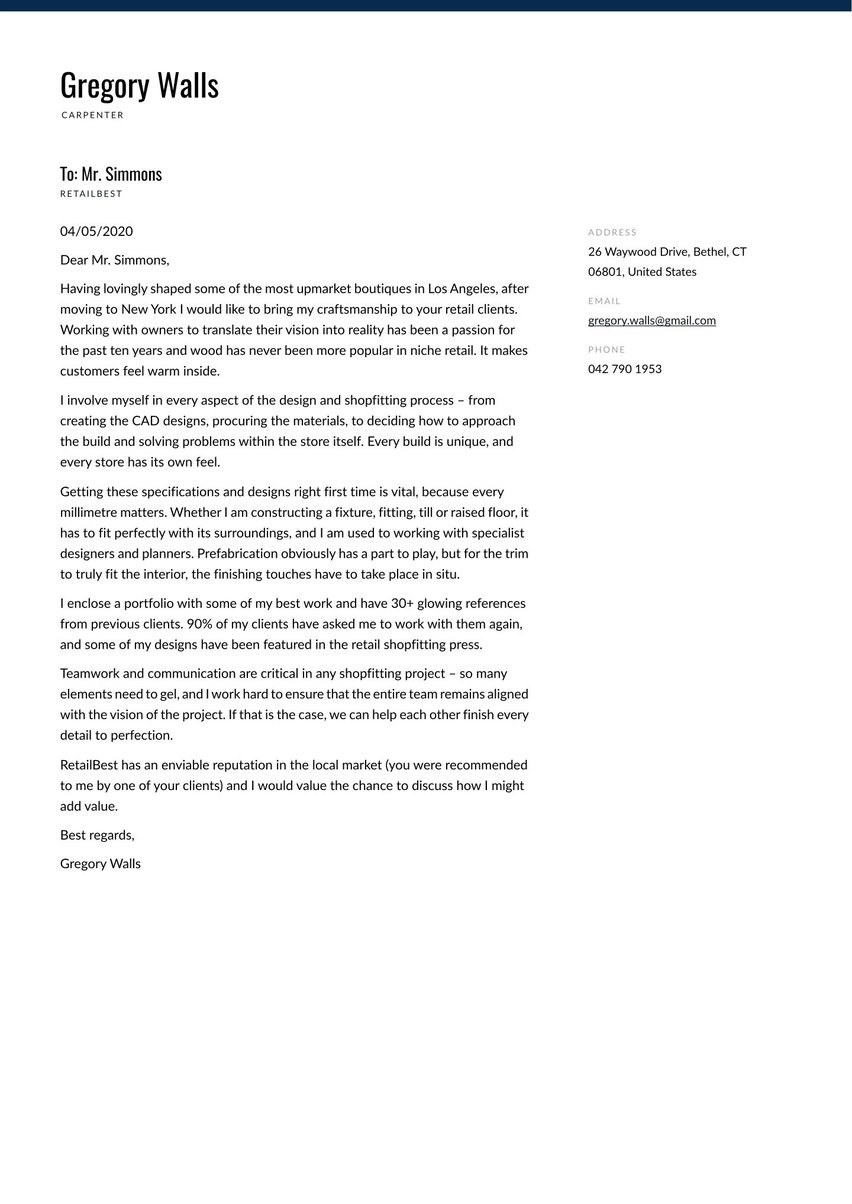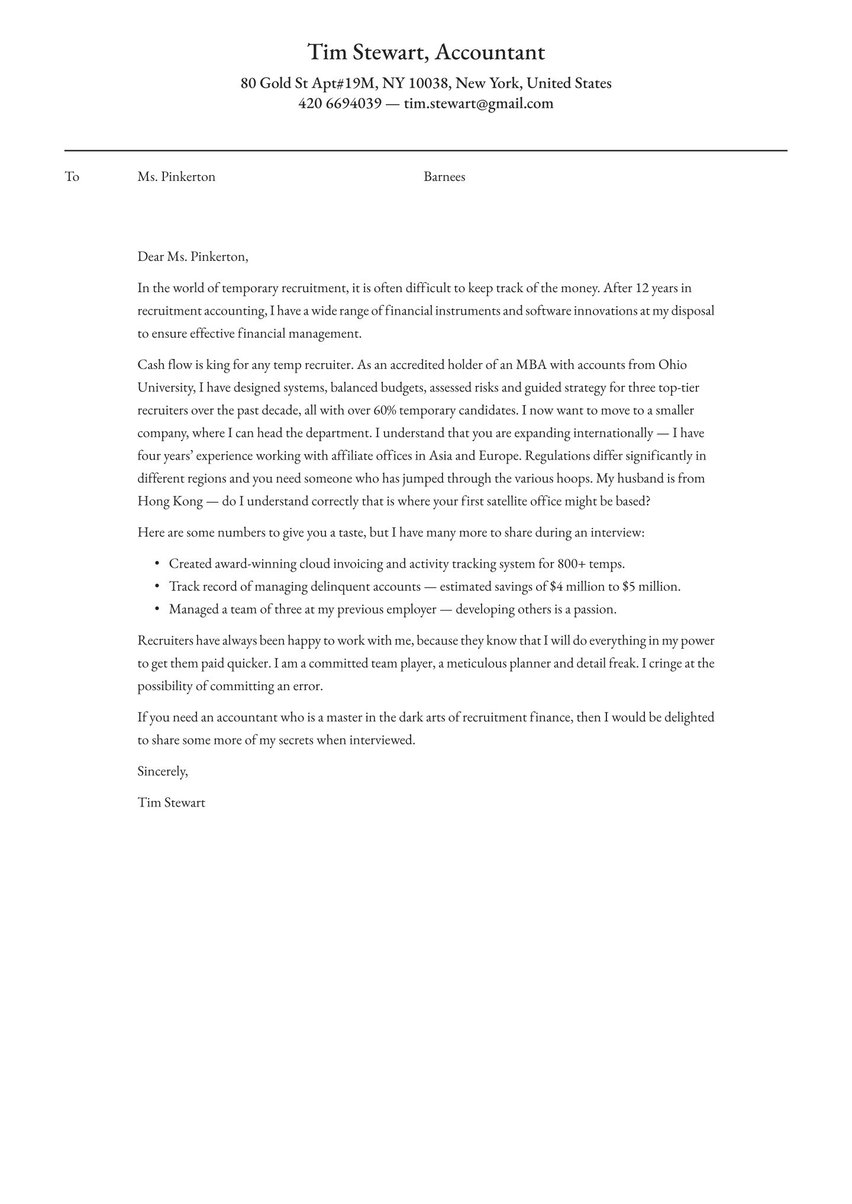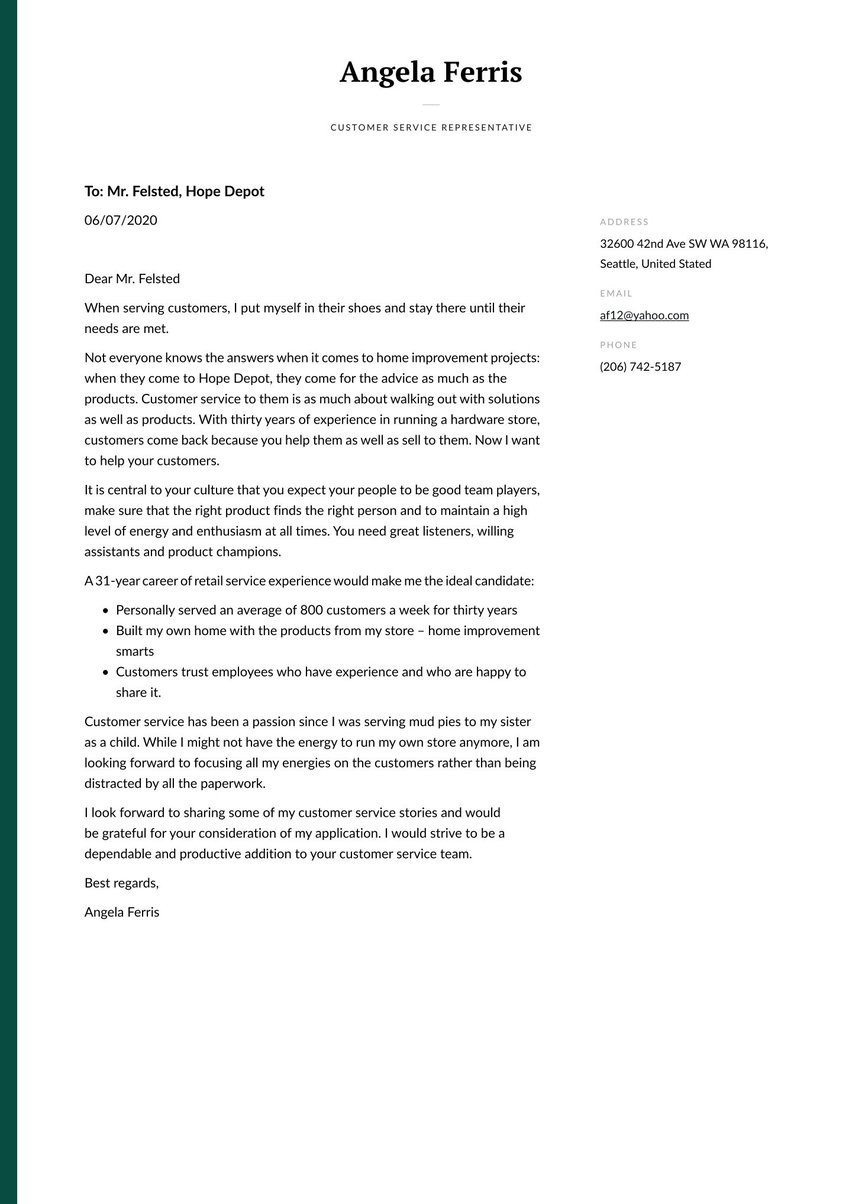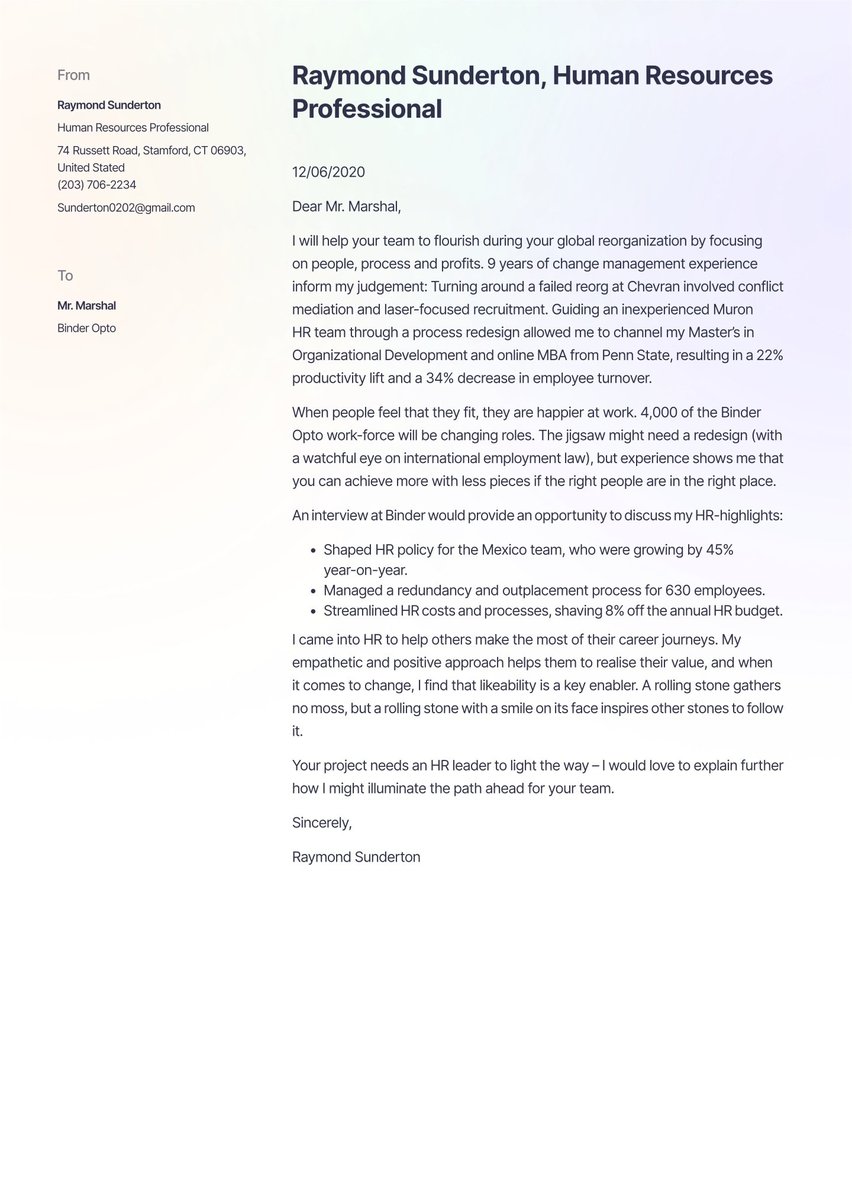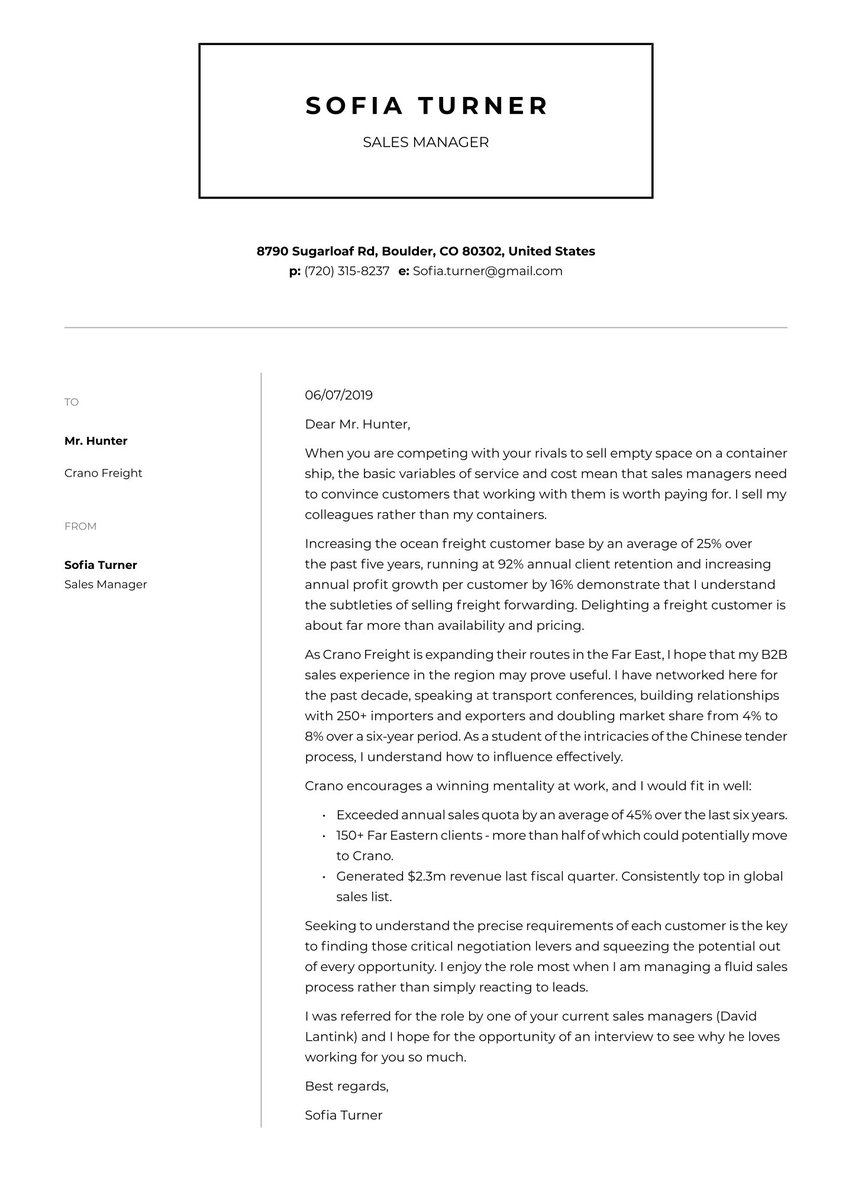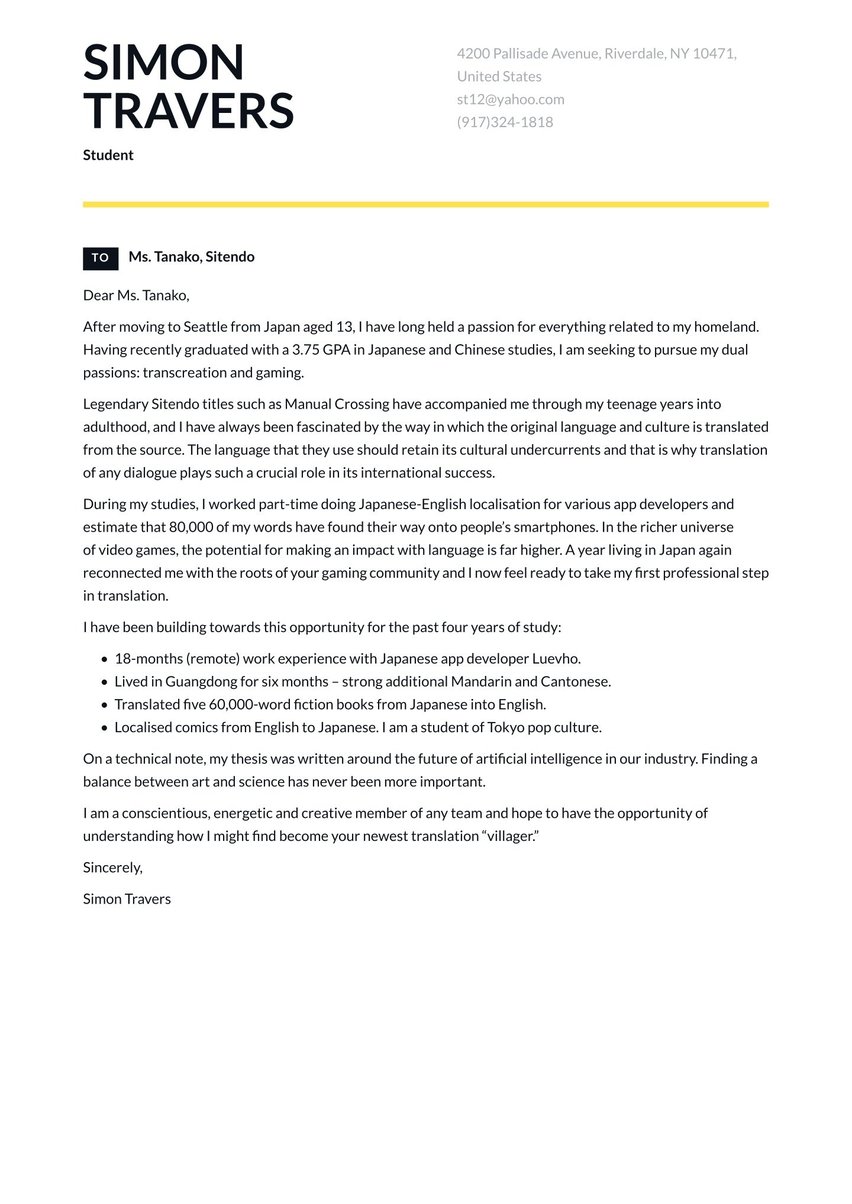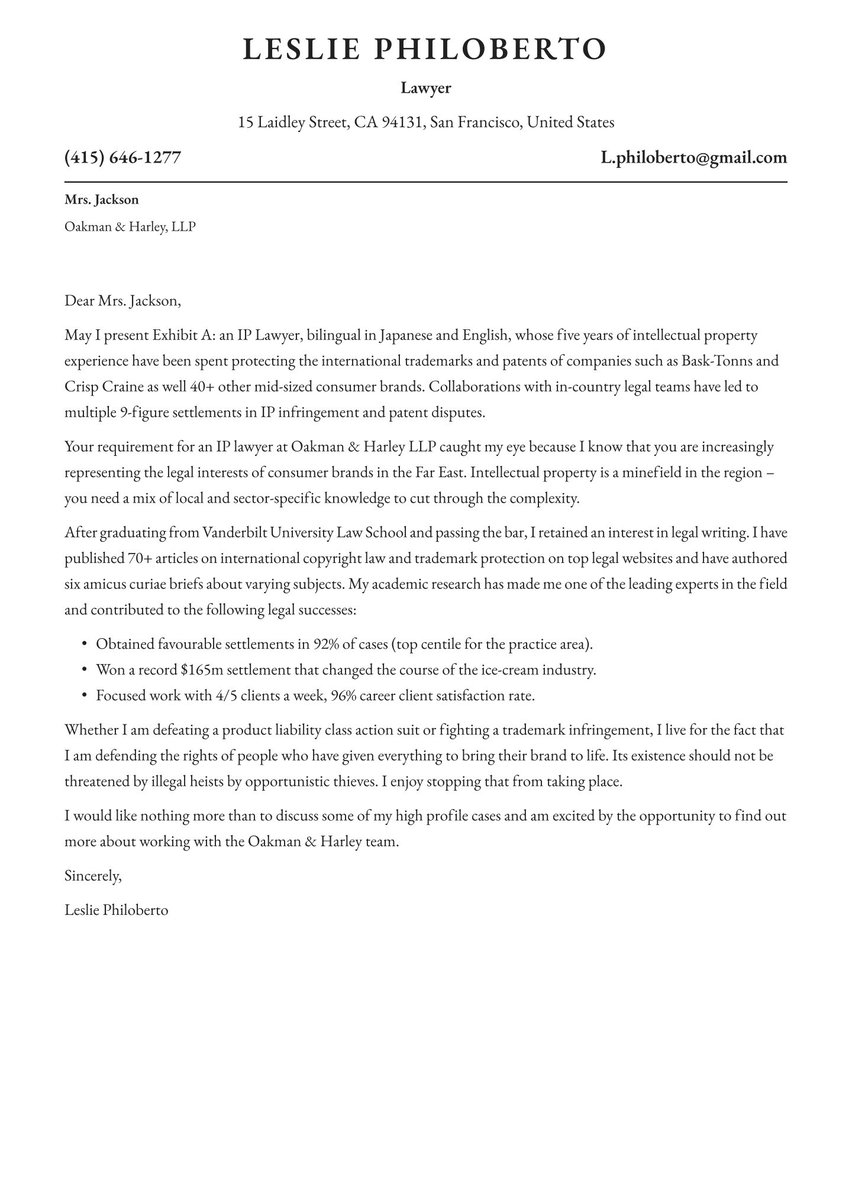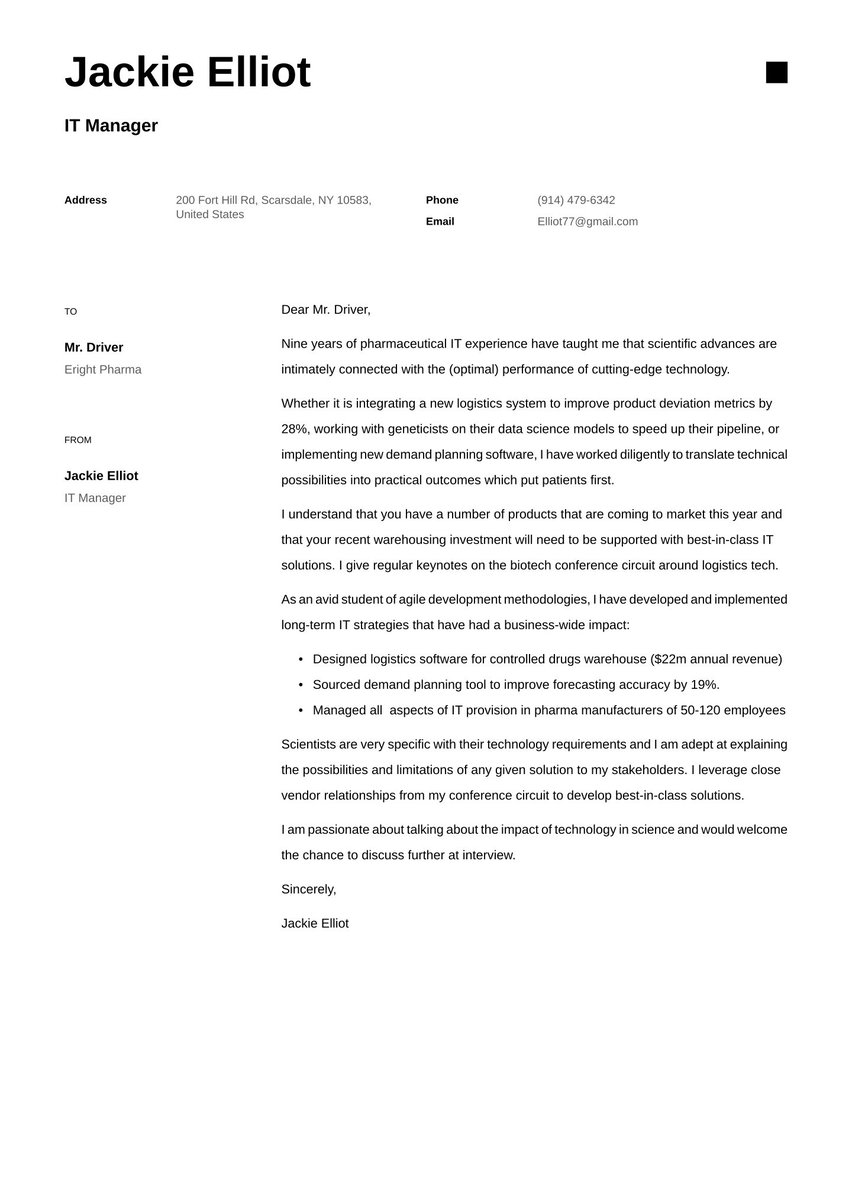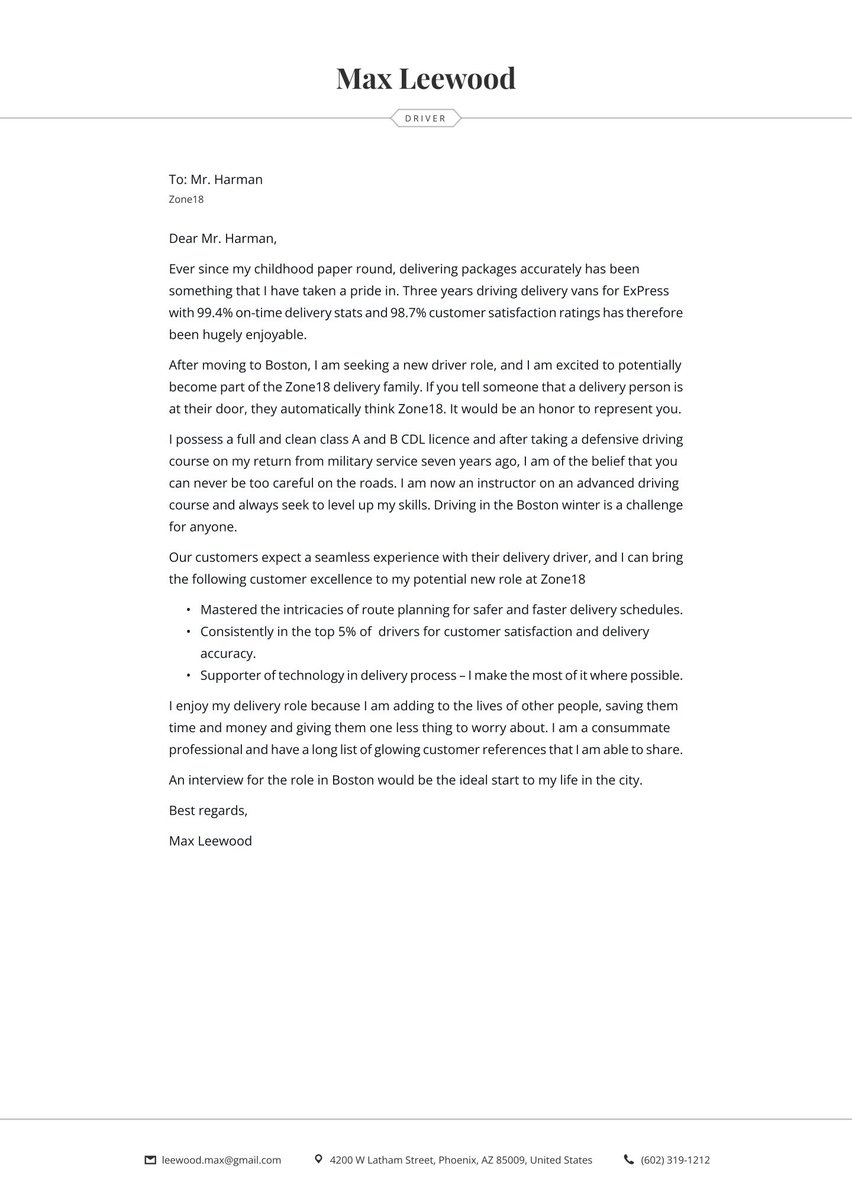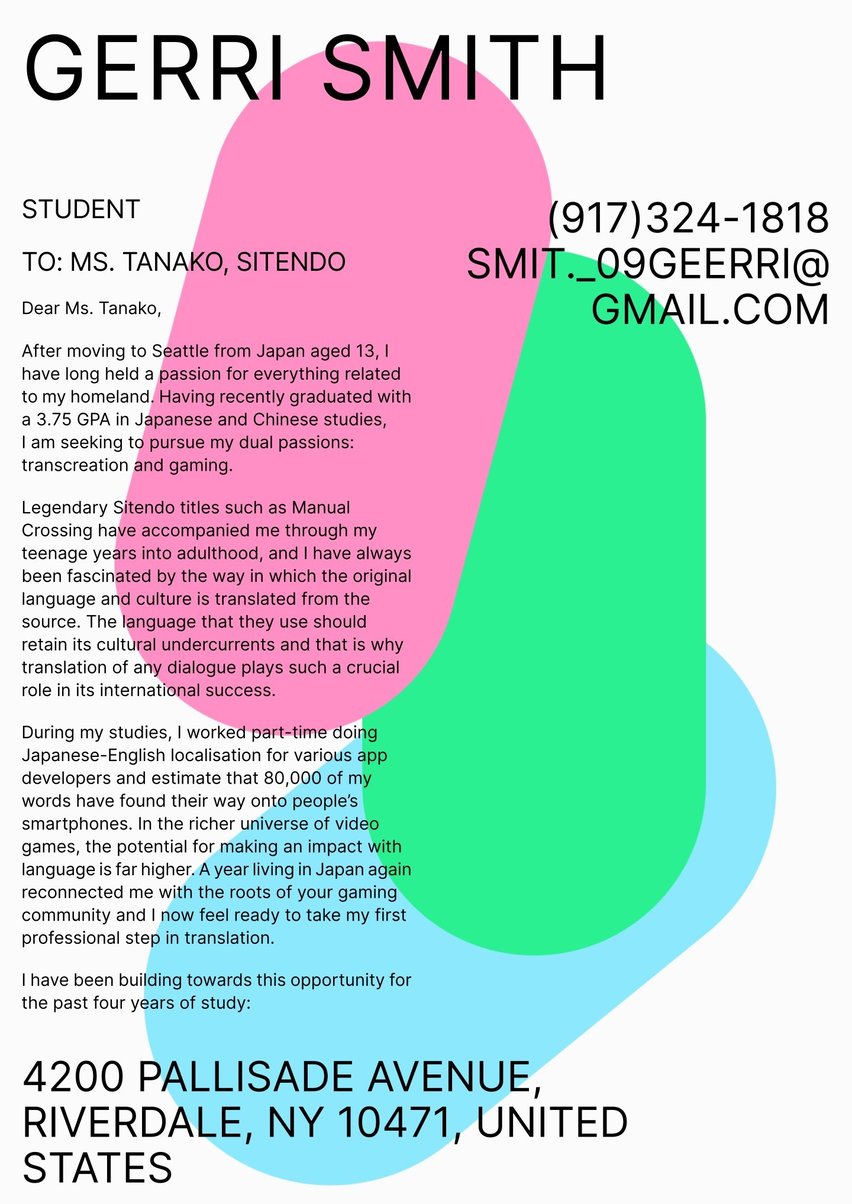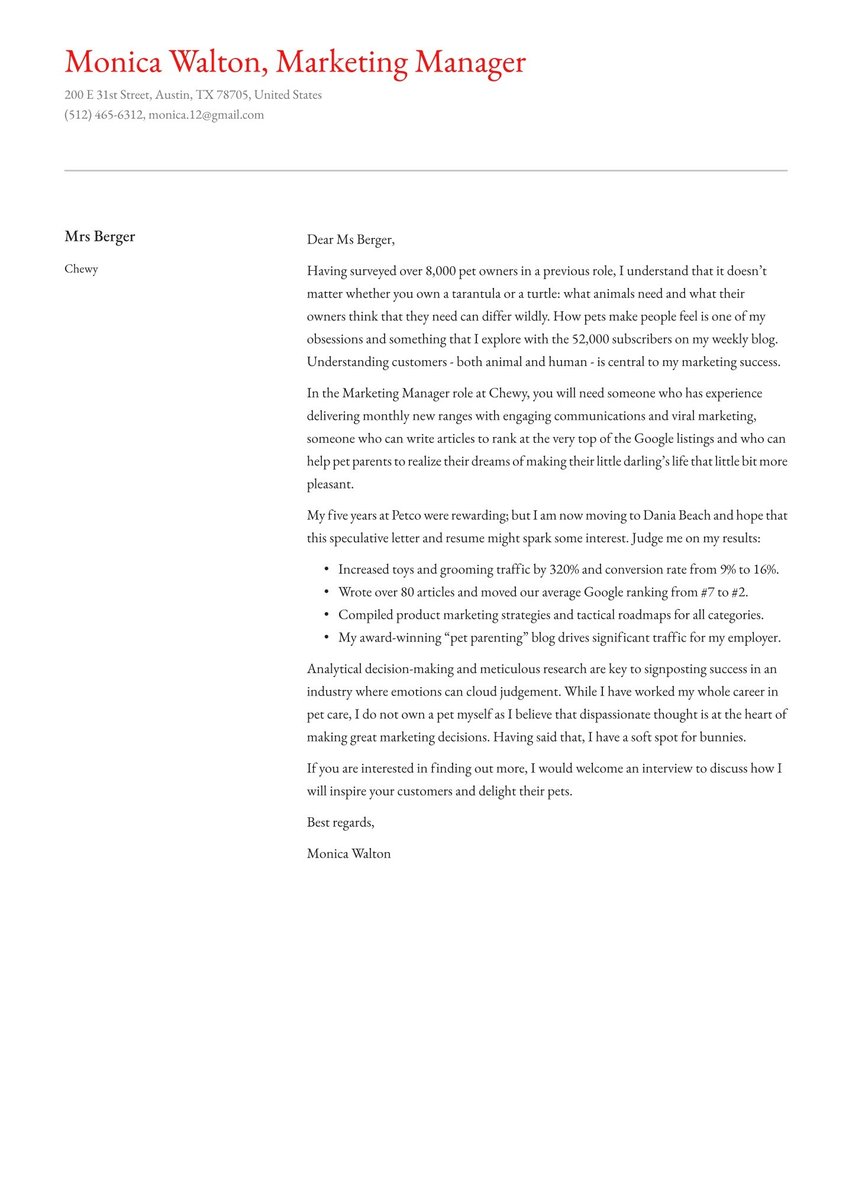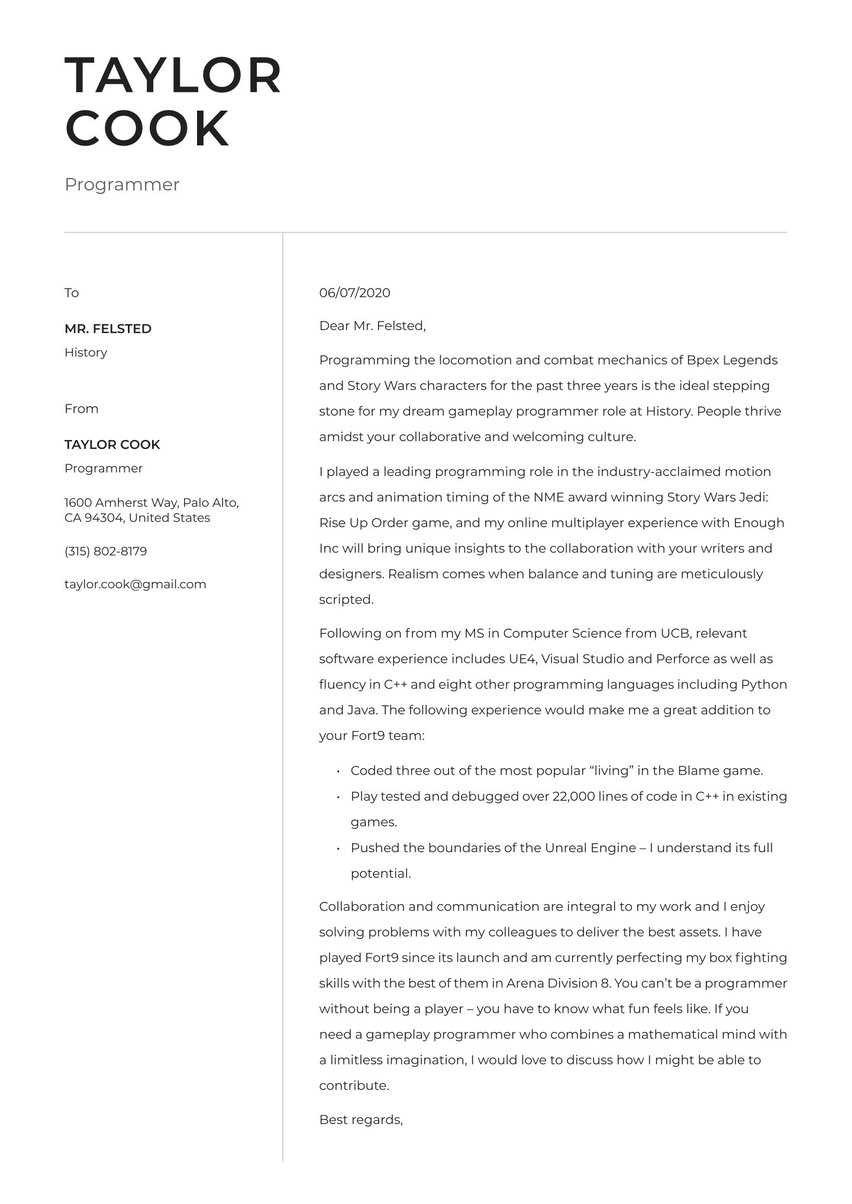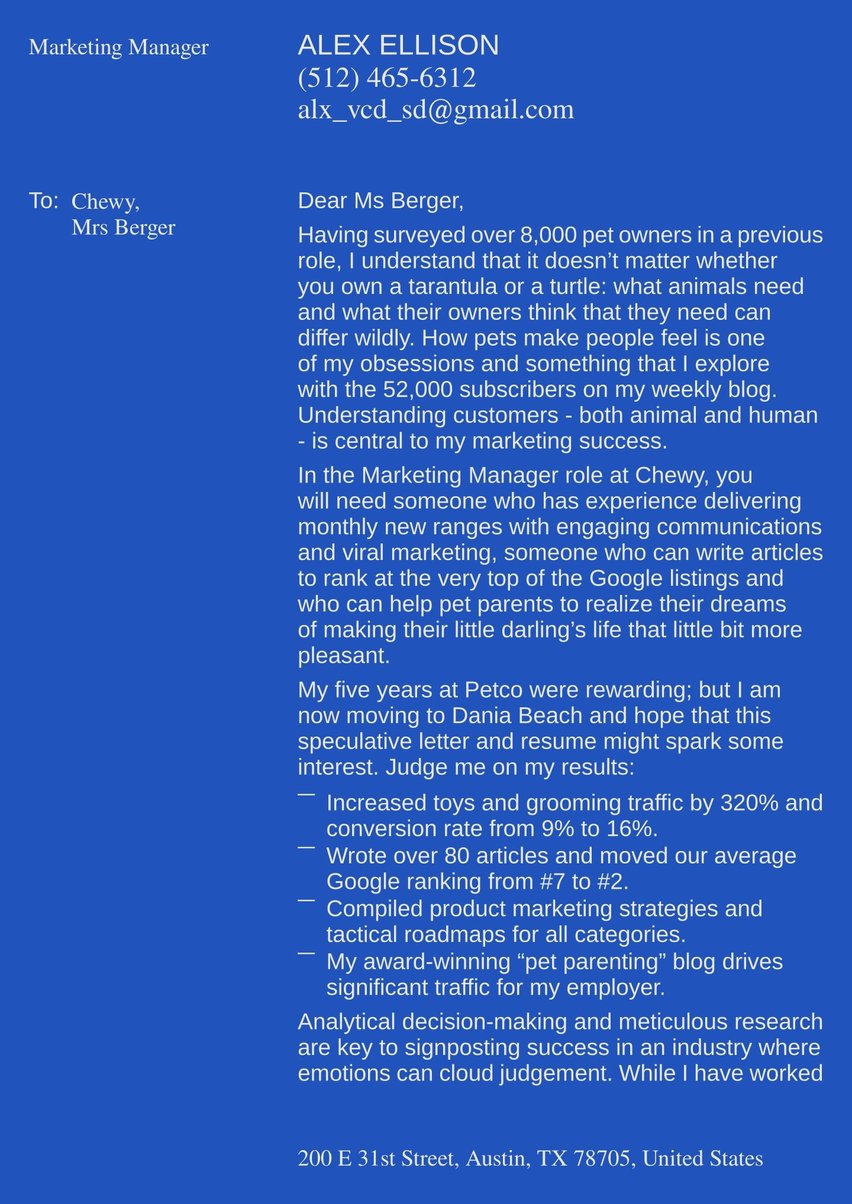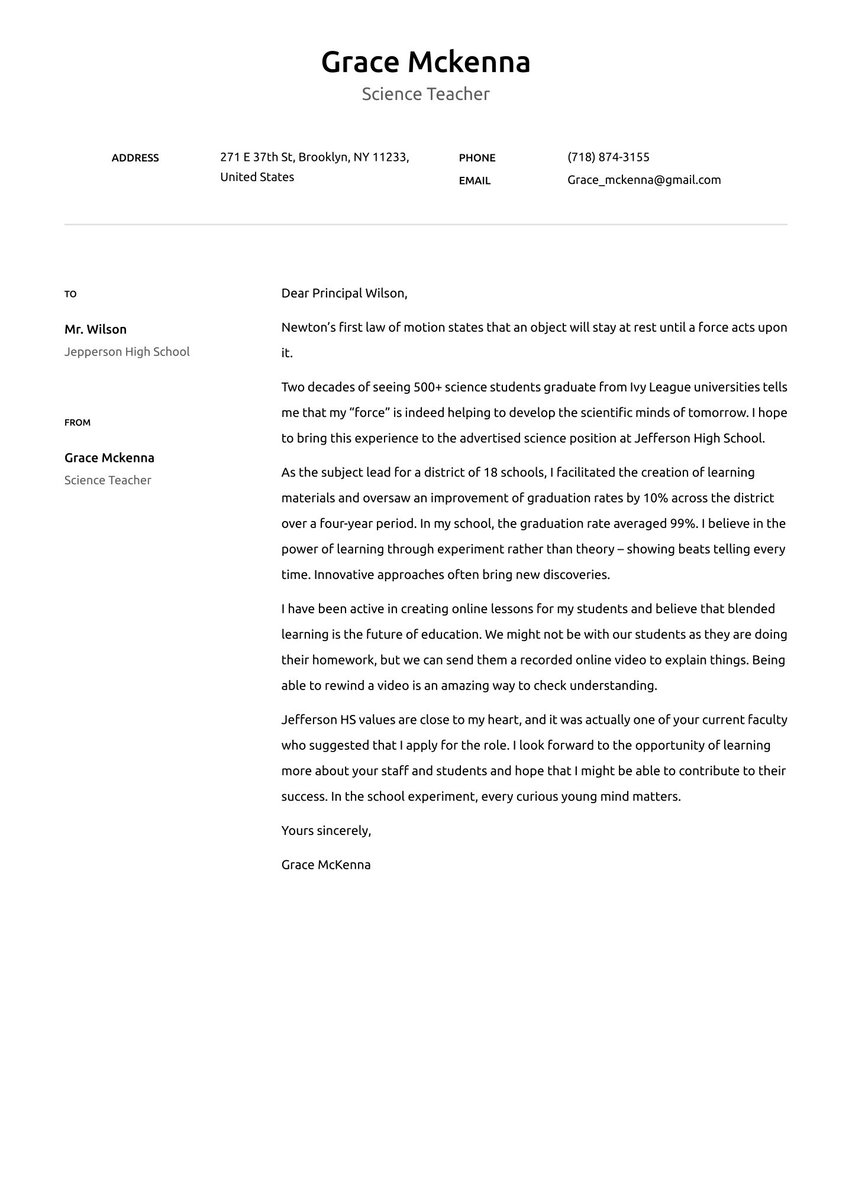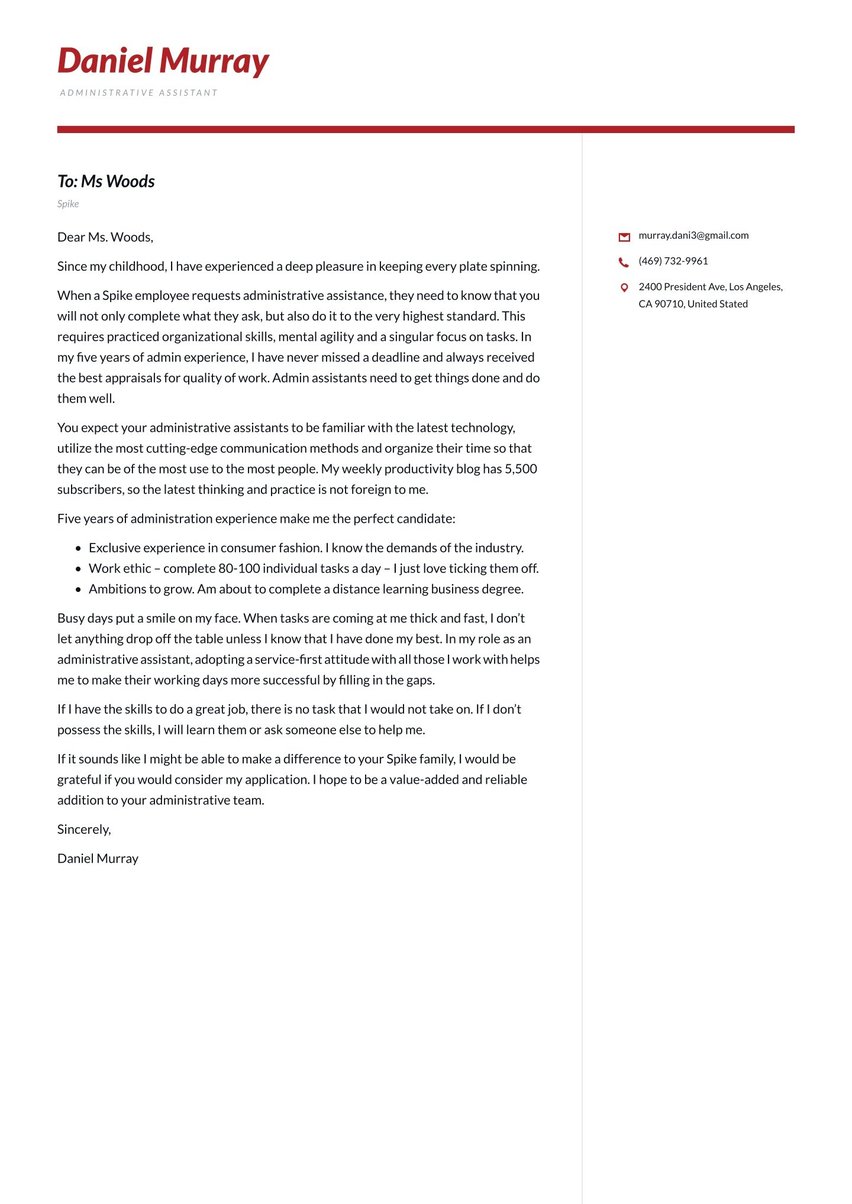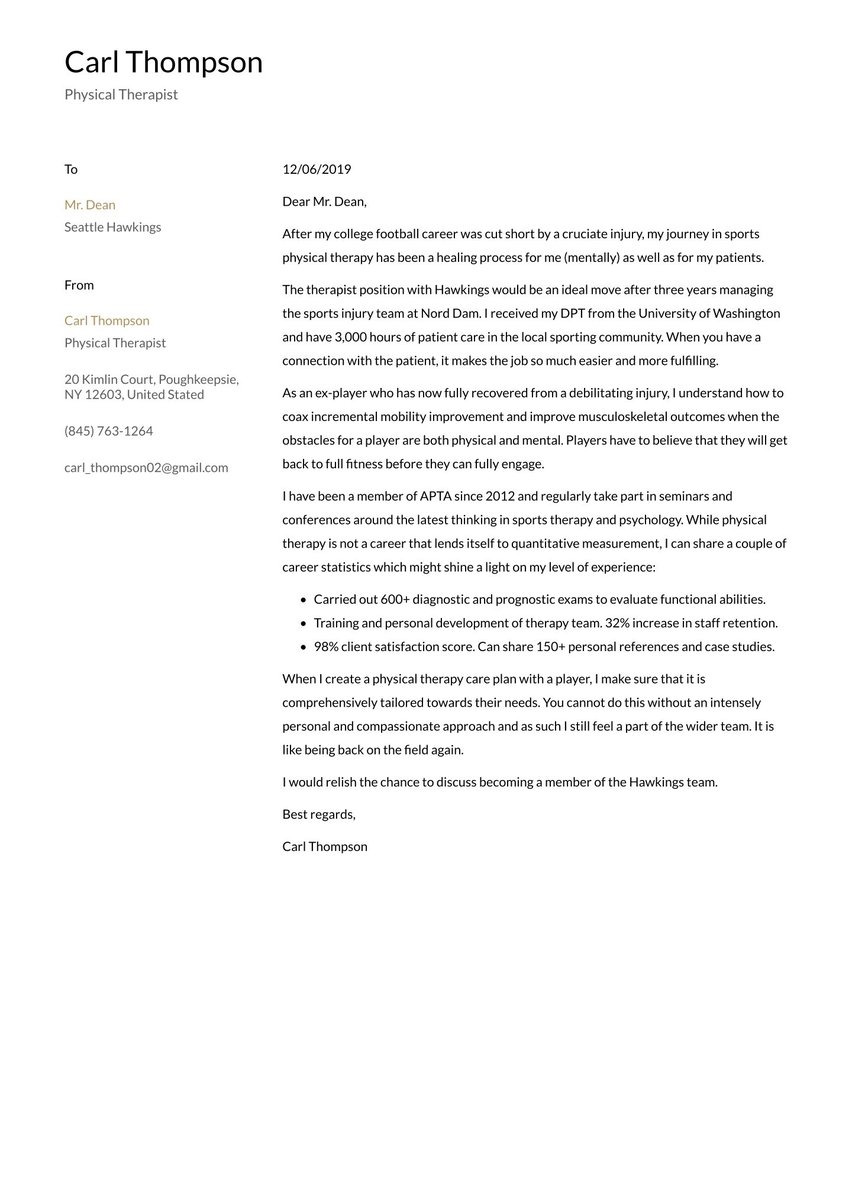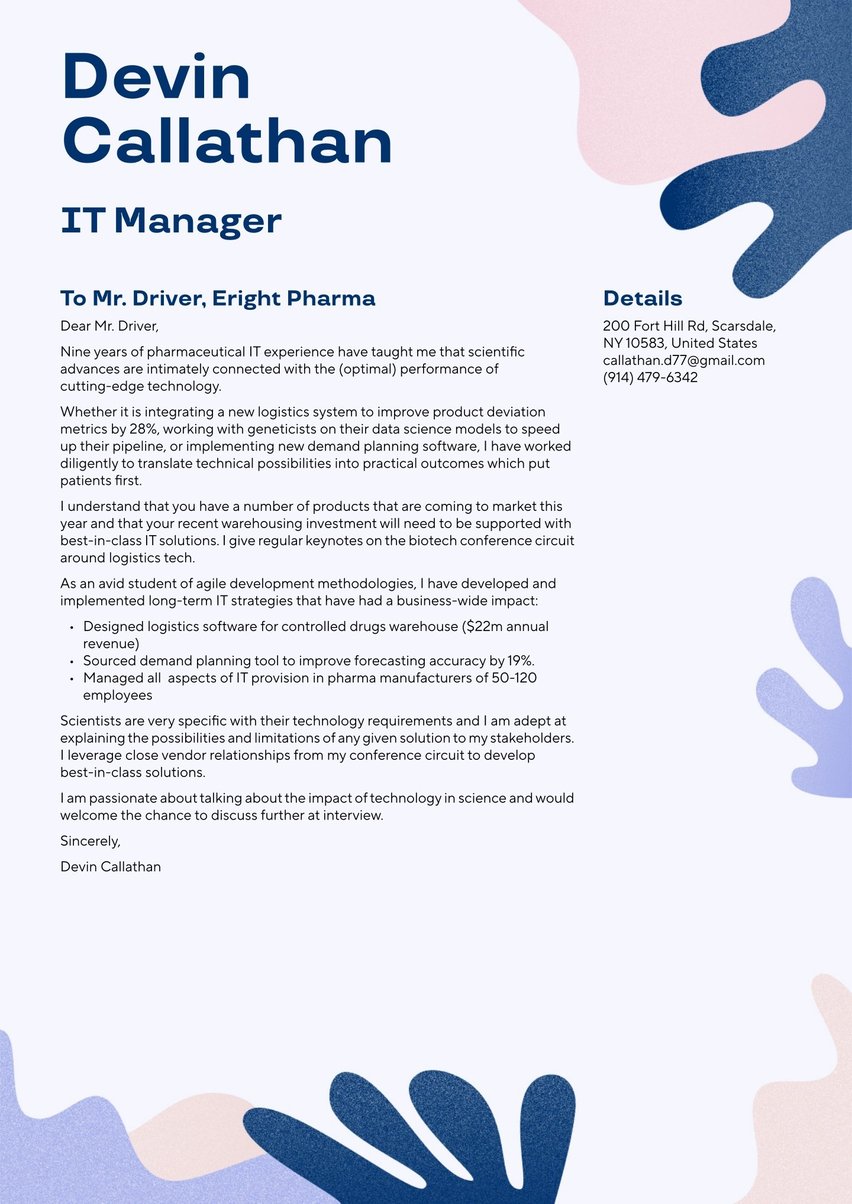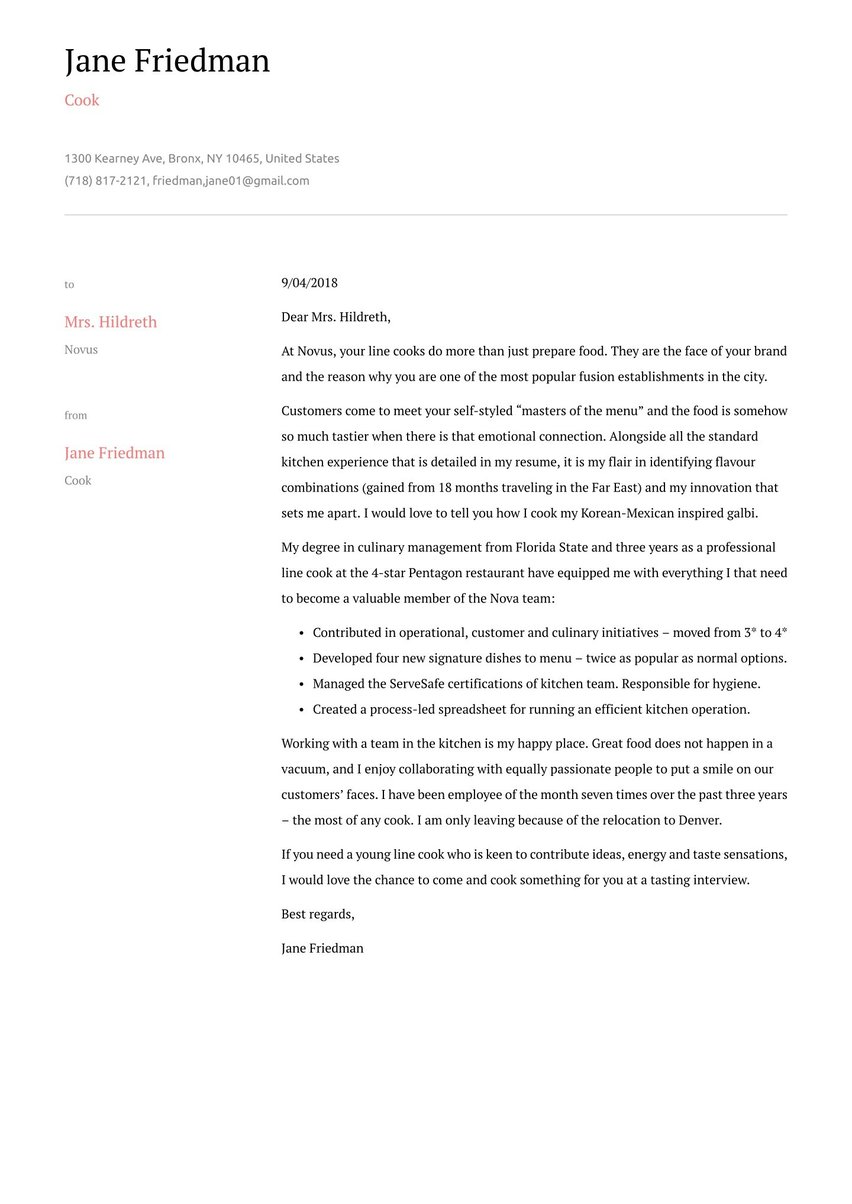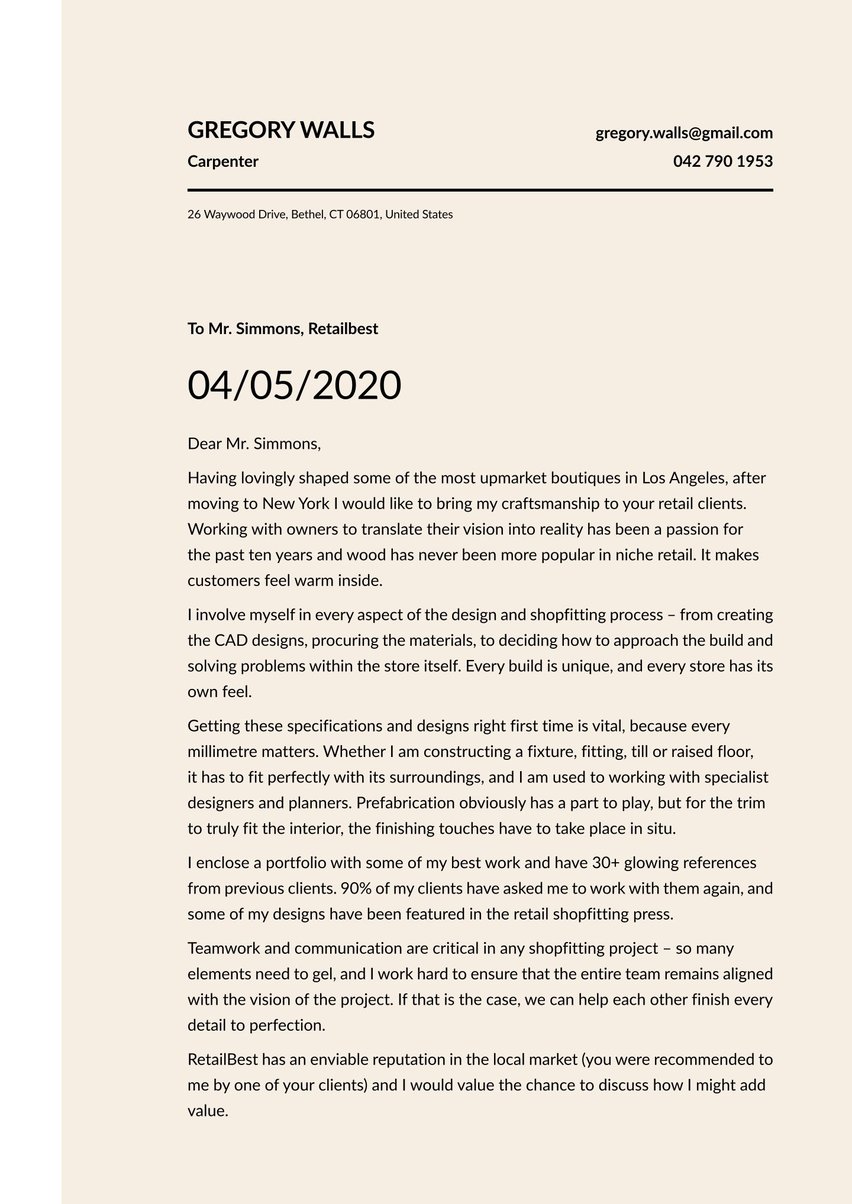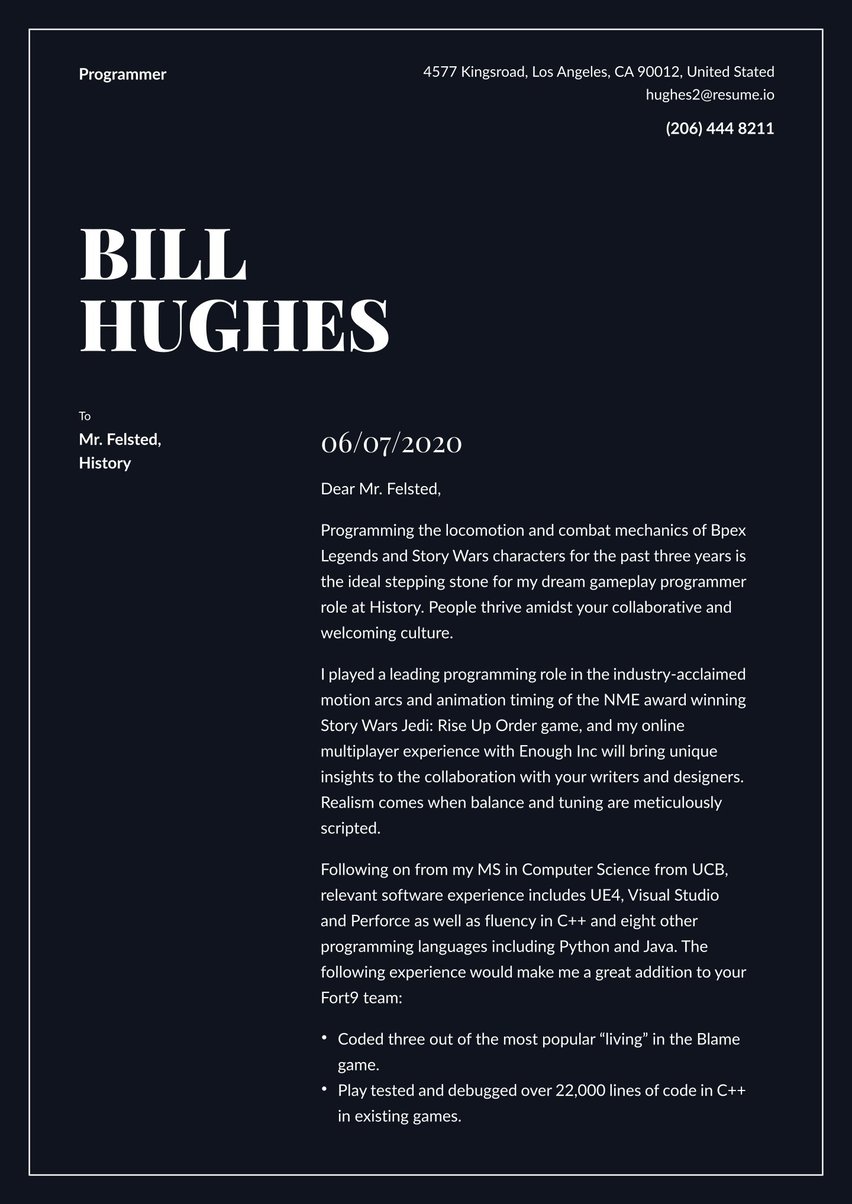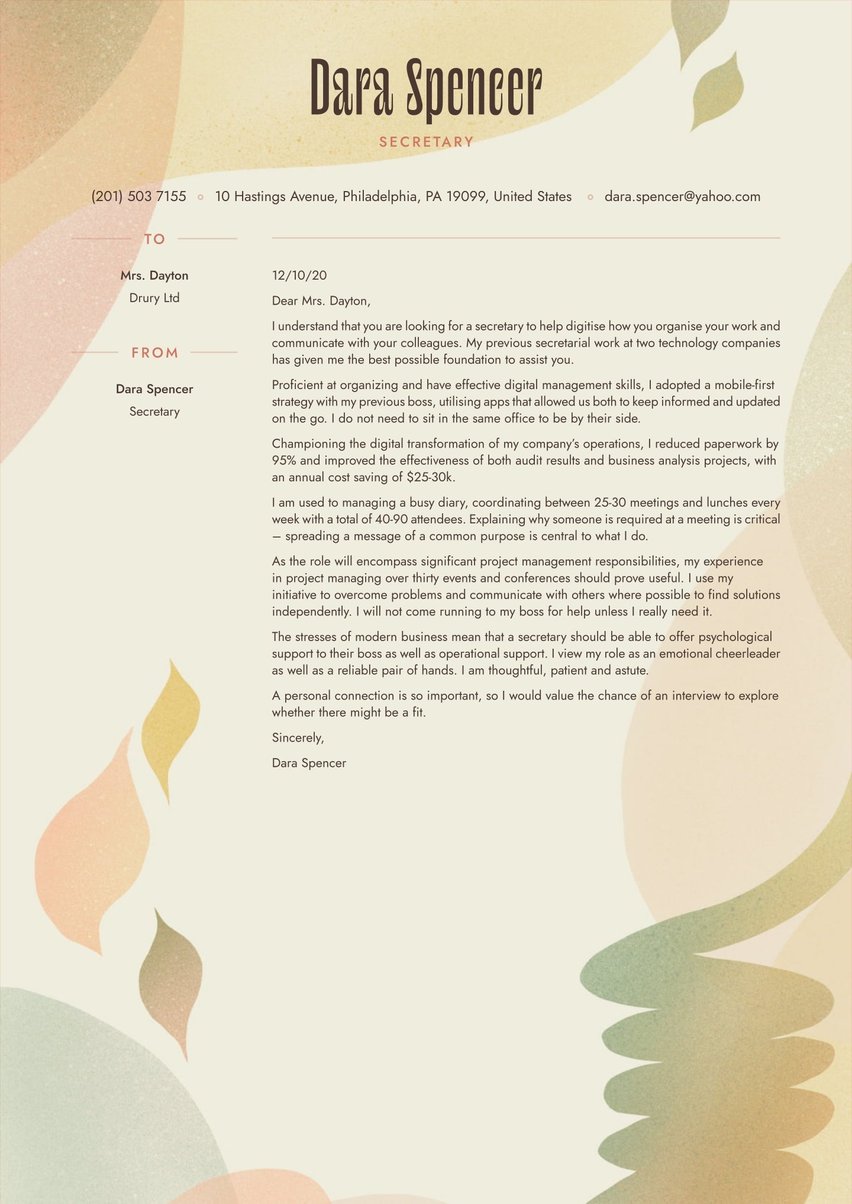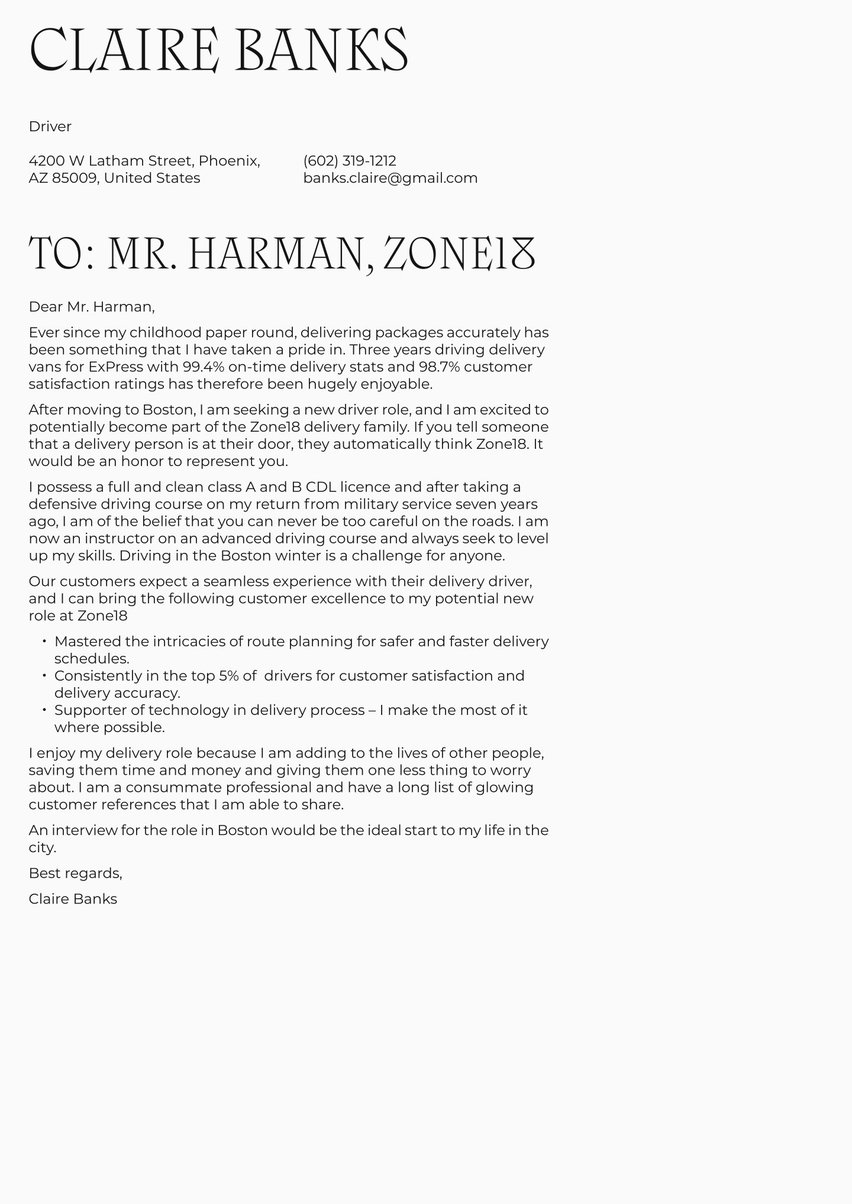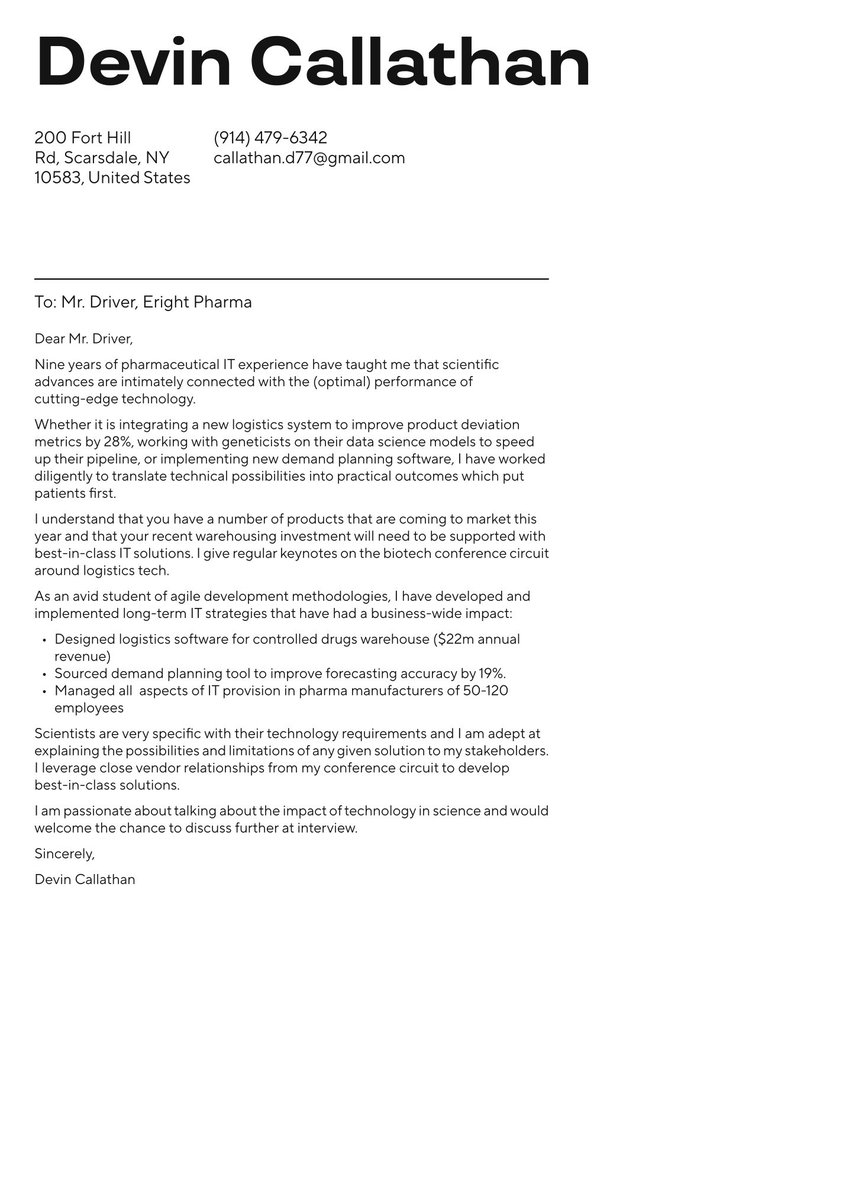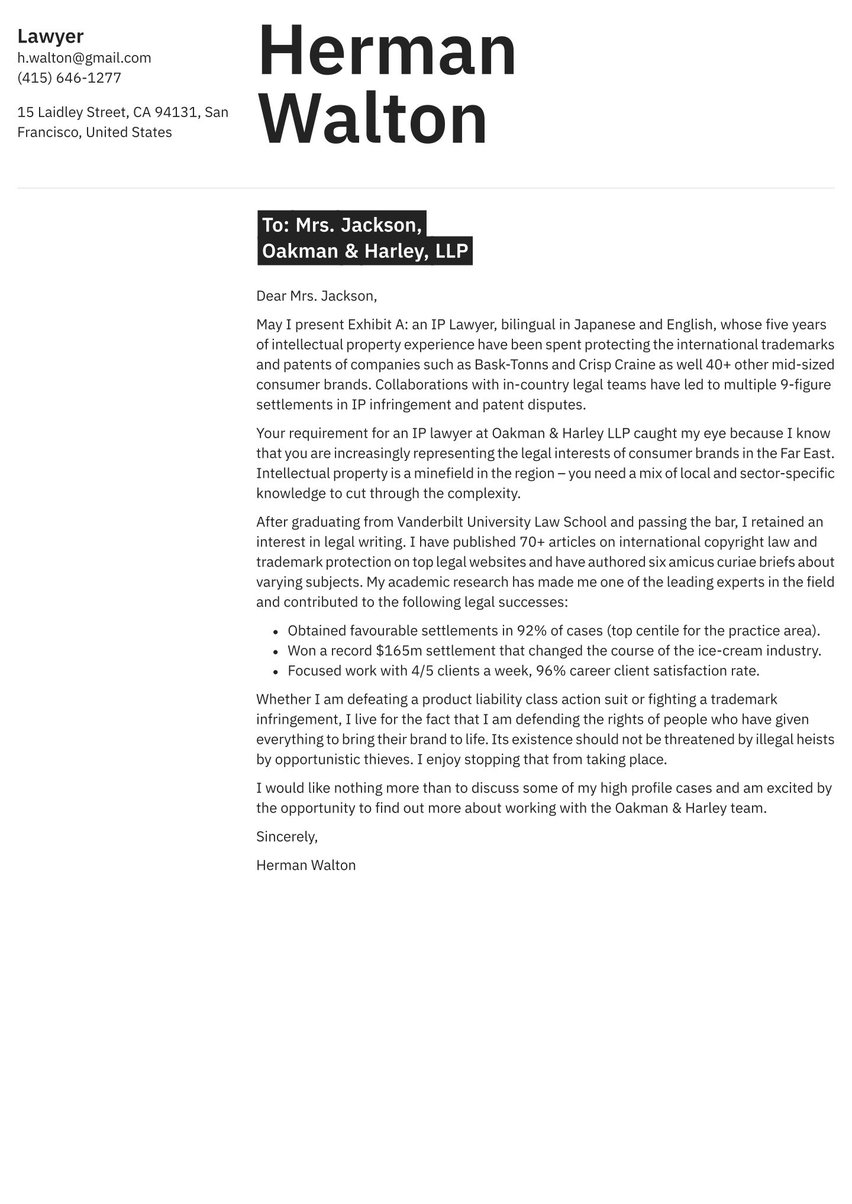If you love people and coffee, working as a barista might be the perfect opportunity to earn some cash, work with a team, and even find a new passion. To prove you have the skills and personality to land the perfect position, you’ll need an epic barista cover letter.
Coffee is one of the most beloved commodities, meaning baristas are always in demand. And in today’s high-end coffee climate, skilled baristas have access to even higher earning potential and long-term career growth.
Whether you’re just looking for a part-time gig or in search of a new profession, a well-crafted cover letter showcases the very qualities and career highlights that make you uniquely qualified for the barista position being targeted.
For expert advice and support with every cover letter preparation step, Resume.io is the right place to turn. Our job-winning resources include a wide selection of occupation-specific writing guides and 180+ cover letter examples. In addition, we offer formatting advice, plus field-tested templates and cover letter builder tools to help you create both resumes and cover letters.
This writing guide, along with an effective cover-letter example, will look at:
- How a cover letter directly increases your chances of landing your dream job
- How to structure your barista cover letter
- Optimizing the impact of each cover letter part: header, greeting, introduction, body and conclusion
- Writing psychology — useful writing tips, especially for candidates with no work experience
- Avoiding common mistakes, including ways to make your cover letter stand out with professional and attractive formatting.
Why a barista cover letter is important
Primary purpose
If you’ve already created your resume, then you know how rigid it can sometimes feel. While it’s great for conveying dates, names and degrees, it doesn’t offer much space to show off your personality and perspectives — vitally important for a barista position.
Enter the cover letter. This one page document — roughly 200 to 400 words — is the perfect complement to a resume. That's because it allows you to focus only on your most impressive accomplishments, relevant skills and key character traits. It’s your way of showing what type of barista you’d make before you ever start your first day of work.
What if the job description doesn't require a cover letter?
Many food service positions at local establishments are filled informally. You may email your application materials or even drop them off in-person. Even if there is an online job description, it may fail to mention anything about a cover letter. In this case, it can be hard to know whether a cover letter is required. So should you write one?
While skipping this step may seem like the easier option, you’d actually be doing yourself a major disservice. Unless an employer specifically asks you to not to submit a cover letter, it’s always a smart idea to include one as part of a complete application. This document allows you to make the best case for your employment and highlight your strengths. Why throw away such a golden opportunity?
Baristas must largely rely on their interpersonal skills during their daily interactions with customers and team members. Your cover letter is the perfect place to show off your cheery disposition, positive attitude and excellent communication.
Secondary purpose
Now that we’ve got a general idea of a cover letter's purpose, let’s talk about why it matters. As you probably guessed, hiring managers for large coffee chains can receive dozens of applications for any single barista position. Even smaller, local coffee shops can get a surprising number of applicants. That’s why a cover letter is all about maximizing your chances. While there’s no single thing you can do to guarantee you’ll land the position, there are many steps you can take to give yourself the best shot at ending the job search. Writing a cover letter is one of them.
A cover letter also helps level the playing field between you and candidates with similar resumes, or even ones with more experience. Since barista jobs often make for great part time or entry-level work, you’ll likely be up against candidates who are students or looking for a first job with a thin resume.
A cover letter is one of the only chances you have to make yourself stand out. It’s worth mentioning that great writing is only half the battle. In order to create a professional application, you’ll also need clean formatting.
Free cover letter templates and the Resume.io online cover letter builder can make creating an attractive design quick and easy. For even more specific direction, check out this comprehensive guide on formatting cover letters.
The importance of tailoring your cover letter
Writing a one-and-done cover letter sounds like a great strategy, but in today’s competitive job market you’ll need to go a step further to ensure your cover letter truly leaves an impact. Hiring managers can easily spot generic cover letters, which can cause you to come across as lazy or disinterested in the position.
To truly maximize your chances of getting the job, you’ll need to make sure you tailor your cover letter for each and every position you apply to. That means choosing the most relevant examples and skills for each coffee shop and adapting your cover letter to show how you’ll meet the employer’s specific needs.
It may take a bit of extra time, but it’s one of the most important steps to take if you’re serious about landing the position.
For more inspiration, you can check out our related hospitality and catering cover letter examples.
- Hospitality cover letter sample
- Restaurant cover letter sample
- Waitress cover letter sample
- Chef cover letter sample
- Cleaning job cover letter sample
- Bartender cover letter sample
- Starbucks cover letter sample
- Server cover letter sample
- Hotel Receptionist cover letter sample
- Travel Agent cover letter sample
- Restaurant Manager cover letter sample
- McDonald's cover letter sample
- Pastry Chef cover letter sample
Best format for a barista cover letter
While a cover letter is significantly more free-form than your resume, that doesn’t mean it’s completely structureless. The sections below will help you break down the writing process into manageable steps so that a manager can quickly understand what you’re trying to say.
Here are the key components:
- The cover letter header
- The greeting / salutation
- The cover letter intro
- The middle paragraphs (body of the letter)
- The ending paragraph of your cover letter (conclusion and call-to-action)
Luckily, this cover letter structure stays the same whether you’re planning to work at Starbucks or an independent coffee shop. It can also help if you ever transition careers. That means learning to write a great cover letter is a skill that will benefit you for years to come.
Dear Mr Fairweather,
People don’t just come to a coffee shop for coffee. My pumpkin spiced latte might have them queueing out the door, but customers expect so much more from a Barista. Coming for a coffee is an experience, a window of contemplation in a busy world. Over the past four years, I have helped over 100,000 people to switch lanes for a few minutes.
Chatting to a friendly barista is a few minutes of your day when you are not glued to your smartphone. The interaction carries no baggage – it is just two human beings engaging in a pleasant chat. Some people really need that.
Soaking in the mechanics of how a much-needed coffee is made is a piece of mini-theatre during a mundane day. I am a coffee fanatic and like nothing more than persuading a customer to try a new recipe.
I understand that your unique proposition revolves around the variety of drinks that you offer and having spent a couple of months with our purchasing team on a secondment, there is little that I don’t know about coffee beans. I was a designated Master Barista, attaining 98% in our annual product knowledge exam.
In my previous role, I won numerous Barista of the Month awards and I take a pride in my coffee art, inventing a number of popular patterns. I am proficient with the mechanical side of the role and was the go-to technician and staff trainer. If you treat a coffee machine right, it is an incredibly reliable piece of kit. I have all relevant safety and sanitation qualifications and am always conscious of improving working standards and procedures.
I would love an opportunity of an interview and maybe come to make some coffee for you.
Sincerely,
Stephanie Maxwell
Cover letter header
An attractive and well-organized cover letter header is essential to making your application stand out and convincing a hiring manager to read the document at all. The purpose of the header is twofold.
Its main job is to showcase your name and contact information to make sure a manager can quickly identify the document as belonging to you. The header also serves to provide a bit of eye-catching formatting. This may be the only place where you can add color or stylish design elements to an otherwise plain sheet of paper. So it’s worth taking a moment to reflect what your cover letter formatting choices say about you as a candidate.
The goal of the cover letter header: Label your document with your name and necessary contact information; create a visually-attractive design.
Align document styles
One of the quickest ways to take your application to the next level is by aligning the document styles of your cover letter and resume headers. This will help you create a “personal brand” – a look and feel that makes your application stand out. Aligning document styles is much easier to do when you have a variety of resume and cover letter templates at your disposal. Save time and effort by checking out from Resume.io's extensive selection.
While choosing a template, it’s a good idea to consider how the employer will receive your visual presentation. Are they a national chain with clean, minimalist branding? Or an eclectic local coffee house with a flair for artistic design? A quick Google search can help you tailor your visual presentation to show employers that you’re the candidate who understands their mission and values.
Cover letter greeting
The right cover letter greeting is key to establishing a personal connection and respectful tone from the beginning of your letter. If at all possible, aim to address the letter recipient by name. “Dear” followed by the correct salutation — "Mr. or Ms. Surname" — works well for formal situations or when you and the employer don't know each other. If you’ve met the coffee shop owner before or it’s a local establishment with a casual vibe, you might opt for “Hi” or “Hello” and even the recipient’s first name.
The goal of the cover letter greeting: Address the employer or manager by name to establish a personal connection and friendly tone.
The importance of names and addressed greetings
If you’ve ever worked as a barista, then you know one of the most important steps of preparing the customer’s order actually has nothing to do with coffee. Writing the customer's name on each coffee cup is a simple action that makes that person feel valued and recognized.
Science has actually proven that humans have a positive reaction to hearing their own name. This technique works not only with coffee cups but also with cover letters. Using the hiring manager’s name in your greeting, shows that you’ve taken some time to understand the business and write a thoughtful cover letter.
However, with large chains that are hiring for multiple locations and positions, it can often be impossible to know who exactly will be reading your cover letter. In that case, there’s no need to go to extreme lengths to find a name. “Dear (Company Name) Hiring Manager” can work well. A collective noun like “Hiring Team” or “Family” can also make for a friendly, yet general greeting.
Dear Mr Fairweather,
Cover letter introduction
Hiring managers are busy people with a lot of applications to get through. That means your barista cover letter opening paragraph needs to get to grab attention and get to the point — fast. An energetic anecdote, interesting personal statement or relevant fact can all make for a great start.
Since this is a service position, make sure your cover letter introduction addresses your strongest skills right from the start and smoothly leads into the body of your letter.
The goal of the cover letter introduction: Create an attention-grabbing opening paragraph by using a relevant fact, anecdote or statement to convey your top skills and encourage the hiring manager to keep reading.
People don’t just come to a coffee shop for coffee. My pumpkin spiced latte might have them queueing out the door, but customers expect so much more from a Barista. Coming for a coffee is an experience, a window of contemplation in a busy world. Over the past four years, I have helped over 100,000 people to switch lanes for a few minutes.
Cover letter middle part (body)
You’ve now reached the body of your barista cover letter, which will make up most of its content. This is the place where you can show off your personality traits and skills to paint a picture of yourself as a high-quality barista. To make writing this section a bit easier, you can divide it into two subsections.
In the first subsection, try out the STAR method to create concise, relevant anecdotes. Describe a Situation, the required Task, your Action and the positive Result you achieved. For this method to work well, you’ll want to choose situations likely to arise in the barista position you are seeking.
In the second section, focus on your skills and potential contributions to this new employer. Show the hiring manager why you should be given a shot.
The goal of the cover letter body: Use the STAR method to craft anecdotes that show your skills, work style and personality. Mention potential contributions to the new position.
Chatting to a friendly barista is a few minutes of your day when you are not glued to your smartphone. The interaction carries no baggage – it is just two human beings engaging in a pleasant chat. Some people really need that.
Soaking in the mechanics of how a much-needed coffee is made is a piece of mini-theatre during a mundane day. I am a coffee fanatic and like nothing more than persuading a customer to try a new recipe.
I understand that your unique proposition revolves around the variety of drinks that you offer and having spent a couple of months with our purchasing team on a secondment, there is little that I don’t know about coffee beans. I was a designated Master Barista, attaining 98% in our annual product knowledge exam.
In my previous role, I won numerous Barista of the Month awards and I take a pride in my coffee art, inventing a number of popular patterns. I am proficient with the mechanical side of the role and was the go-to technician and staff trainer. If you treat a coffee machine right, it is an incredibly reliable piece of kit. I have all relevant safety and sanitation qualifications and am always conscious of improving working standards and procedures.
How to close a barista cover letter (conclusion and sign-off)
Upon reaching the conclusion of your barista cover letter, all that’s left is to wrap it up and encourage the hiring manager to contact you for an interview. An effective call to action will help you do just that. This allows you to express enthusiasm for the position and invite a hiring manager to get in touch.
You may choose to leave contact information like your phone number here as well. Then, finish your cover letter with a respectful conclusion. “Sincerely,” “Best regards” or even “Thank you” can work well depending on your relationship with the cafe.
The goal of the cover letter conclusion and signature: Create a call to action that finishes your letter on a positive note and invites the hiring manager to schedule an interview. Close the letter with the appropriate signature.
I would love an opportunity of an interview and maybe come to make some coffee for you.
Sincerely,
Stephanie Maxwell
Writing psychology: serving up your soft skills, even without experience
When applying to a barista position, there are a few key traits you’ll want to convey.
- Efficiency: When it’s time for the morning commuter rush, baristas need to work quickly under pressure. Spills, messes, and not being able to multitask slows down the line and makes for unsatisfied customers. Examples of times when you completed many orders correctly and quickly can show a future manager what type of work ethic you have.
- Attention to detail: Today’s customers have high expectations for their made-to-order coffee drinks. Getting your lattes, cappuccinos and espressos in order can go a long way to make sure customers are happy and the business doesn’t lose money on a wasted cup of coffee. In your cover letter, you can also discuss your ability to learn new products or memorize regular customers’ orders.
- Positive attitude: Baristas interact with dozens, if not hundreds, of people every day. A cheerful disposition, combined with a high level of patience, helps make each encounter with you pleasant — both for customers and other employees.
- Customer service skills: As with all food service positions, the customer rules. Making each and every passerby feel welcome and cared for will greatly boost the coffee shop’s reputation. You can communicate customer service and communication skills not only through examples but also the tone and professionalism flowing through your letter.
Barista cover letter with no experience
Barista positions often make great part-time work for students and first-time job seekers. However, today’s openings are becoming increasingly competitive. As a candidate with no direct experience in the position, you’ll need to work a little harder to make sure your application stands out. Luckily, the cover letter is your secret weapon. This document may become even more important than your resume as it allows you to convince a manager that they should take a chance on you versus other applicants with more years of experience.
In this situation, you’ll want to focus your cover letter mainly on soft skills – or the innate personality traits that are applicable across all industries. Luckily, baristas often rely on soft skills to create customer satisfaction and a positive atmosphere. Managers know many of the coffee-making duties can be learned in a matter of weeks, so choosing candidates with the right attitude and willingness to learn is key.
You can also discuss other volunteer positions or jobs that have allowed you to cultivate similar skills to the ones needed as a barista – things like work ethic, attention to detail, timeliness, communication skills and flexibility.
It’s all in the details
It’s a well-known marketing principle that a message with a sprinkling of specific details becomes much more memorable to the audience than a generic message with no concrete facts.
Use this law of specificity to your advantage by including enough details in your cover letter to stand out as a candidate. A few well-placed numbers, statistics and descriptions can all help a reader envision where you’ve worked and what you’ve learned.
Some common sources of numbers for your cover letter:
- how many clients you served on an average day
- how many team members you managed]
- how many shifts you served on the cash register
- how many menu items you memorized
- how many locations you worked in.
Basic mistakes in a barista application letter (and how to avoid them)
Let’s take a look at some common pitfalls that might trip up other candidates for barista jobs.
- Generic cover letters: Since many barista jobs require similar skills, it might be easy to write a cover letter that could work for a variety of employers. However, taking a few extra minutes to explain why you have an interest in working for each particular brand can go a long way in making your cover letter stand out as sincere and professional.
- Irrelevant experience: Many candidates apply to barista positions with no experience. If that’s you, make sure to focus on other activities or jobs with transferable skills. You’ll need to make an extra effort to show why your volunteer position truly relates to life as a barista.
- Poor formatting: Visual presentation should be at the forefront of any great application. Don’t forget to pay attention to font styles and sizes and the balance of white space to text. A modern resume template and a matching cover letter design can help you create a polished look.
- Typos and grammar mistakes: Spelling errors and poor sentence structure look sloppy and unprofessional. Worse, they can dissuade a hiring manager from ever finishing your letter. Solve this problem by using spell check and asking a friend to proofread your letter before you submit your application.
Key takeaways for a barista cover letter
- A cover letter is an essential part of any complete application — even in informal hiring processes. Unless a manager tells you NOT to submit a cover letter, it’s worth your time to write and submit one to maximize your chances of landing the position.
- To truly give yourself the best shot at landing your dream barista job, you’ll need to show an employer why you’re interested in their coffee shop or cafe. Tailoring your cover letter is an important part of the writing process.
- Use the trusted organizational structure to write your cover letter quickly and efficiently. These sections also make it easier for an employer to understand what you have to offer.
- When applying to a barista position with no previous experience, make sure to focus on transferable skills and relevant experiences.
- Cover letter formatting should never be an afterthought. Try out Resume.io’s collection of free cover letter templates to create a great design in a few clicks.


